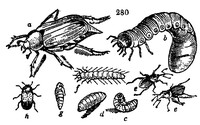1627. The cockchafer (Melolontha vulgaris F., fig. 280. a, b) is one of the most destructive insects in this country. It is provincially called brown tree-beetle, blind-beetle, chafer, Jack horner, Jeffry cock, May-bug, brown clock, dor, and miller. This insect appears some years in prodigious numbers, committing, both as a grub or larva and in its perfect state, the greatest ravages. The female (a) deposits her eggs in the ground, where in a short time they change into young grubs: these, when full fed, are about an inch and a half long (b); they are soft and white, with a reddish head and strong jaws. In this state the insect remains four years, during which time it commits dreadful ravages on the roots of grass, plants, and even young trees; gnawing away the fibres and bark, and devouring the roots, especially in old pastures, so that the turf becomes brown, and may be rolled up nearly with as much ease as if it had been cut artificially; when the grubs will be found beneath it, lying on their sides within the mould; and vast numbers may be thus gathered, and given to poultry and swine. When full grown, the larvï¾µ dig in the earth four or five feet deeper, spin a smooth case, and then change into the chrysalis state (fig. 279. a). In this inactive form they remain until the following spring; the perfect beetle (fig. 280. a) then comes from the ground, and commences an immediate attack upon the leaves of all trees, but more particularly on those of the oak. The following account of the ravages of this insect is so very extraordinary, that, were it not well authenticated by contemporary writers, it would appear incredible. In 1688, the cockchafers appeared on the hedges and trees in the county of Galway, in clusters of thousands, clinging to each other's backs in the manner of bees when they swarm. During the day they remained quiet, but towards sunset the whole were in motion; and the humming noise of their wings sounded like distant drums. They were in such prodigious multitudes, that they darkened the air for the space of nearly three miles; and the noise they made in devouring the leaves was so loud, as to have been compared to the distant sawing of timber. In a short time the leaves of all the trees, for some miles, were destroyed, leaving the whole country, in the middle of summer, as naked and desolate as it would have been in winter. Swine and poultry devoured them in vast numbers; they waited under the trees for the clusters dropping, and soon became fat upon this novel food: even the lower orders of the people, from these insects having eaten up the produce of the earth, adopted a mode of cooking them, and also used them as food. Towards the end of summer, they are said to have suddenly disappeared. (Phil. Trans., 1697, vol. xix. p. 743, &c.) From subsequent facts, there is reason to believe that these insects occasionally migrate into this country from some part of the Continent, probably Normandy or Britany; as, about 1802, all along the south-west coast of Galway, there were found dead on the shore, for miles together, such infinite multitudes of cockchafers, and in such vast heaps, that, by a moderate estimate, it was computed there could not be less than forty or fifty horse-loads in all. These were doubtless a new colony, intercepted by a storm in their flight to the same districts as had been ravaged by their ancestors; but which, meeting with a contrary wind, had been driven into the sea, and destroyed. (Shaw's Gen. Zool.)

